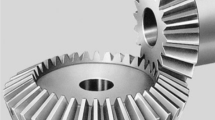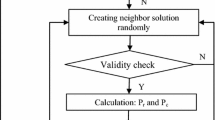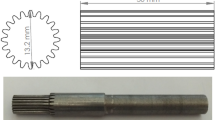Abstract
Optimizing the design of the preform shapes used in warm forging processes is important for improving quality and reducing cost. The main objective of this study was to optimize the design of a preform shape for a bevel gear to obtain a good product and to improve the efficiency of the warm forging process. Quality parameters included in the fitness function were form-filling, preform volume, and complexity. First, basic principles pertaining to the cross sections, thickness, and concave radius of a bevel gear preform were applied in conjunction with certain theoretical expressions and empirical methods to produce an initial preform shape and initial geometry. Subsequently, mathematical evaluation models of the fitness function were generated to optimize the preform shape. Finally, a genetic algorithm was applied to solve the multi-objective optimization problem, and the best solution was determined considering the accuracy of the results, within the close proximity set generated by the multi-objective genetic algorithm optimization. The optimal preform shape was decreased in weight by approximately 8% and its flash dimensions were decreased by about 5% compared to the initial preform shape. This research is expected to improve the efficiency of fabricating bevel gears by means of warm forging processes.
Similar content being viewed by others
Abbreviations
- A P :
-
cross section of preform
- AF :
-
cross section of final shape
- t P :
-
thickness of preform
- t F :
-
thickness of final shape
- rf P :
-
fillet radius of preform
- rb P :
-
blend-in radius of preform
- B :
-
chamfer length
- D :
-
large diameter
- H :
-
height
- Ac :
-
depth of adjacent cavity
- F filling, n :
-
form-filling of individual at cutting plane n
- A i, n :
-
cross-sectional area of individual at cutting plane n
- A F, n :
-
cross-sectional area of final shape at cutting plane n
- a :
-
amount of flash
- F filling, i :
-
form-filling fitness
- V i :
-
total volume of the individual
- F filling, i :
-
form-filling fitness
- V i :
-
total volume of the individual
- V F :
-
volume of the final shape
- F filling, i :
-
form-filling fitness
- V i :
-
total volume of the individual
- V F :
-
volume of the final shape
- r n :
-
radius at cutting plane n
- V min :
-
minimum possible preform volume
- V max :
-
maximum possible preform volume
- F volume, i :
-
volume fitness
- r i, n :
-
radius of individual at cutting plane n
- C i :
-
complexity of individual
- C min :
-
minimum possible complexity
- C max :
-
maximum possible complexity
- F complexity, i :
-
complexity fitness
- f W :
-
flash width
- f t :
-
flash thickness
- R h :
-
radial distance of the center of outside diameter
- F i :
-
total fitness value
- w1:
-
weight factor 1
- w2:
-
weight factor 2
- w3:
-
weight factor 3
- wp :
-
workpiece weight
- I :
-
population size
- Pc :
-
crossover rate
- m :
-
mutation rate
- Tc :
-
termination criterion
References
Barbara, R., Lorenzo, D. and Luca, T. (2017). Multi-goal optimization of industrial extrusion dies by means of meta-models. Int. J. Advanced Manufacturing Technology 88, 9–12, 3281–3293.
Bilgin, M. B., Meran, C. and Canyurt, O. E. (2015). Optimization of strength of friction stir welded joints for AISI 430 ferritic stainless steels by genetic algorithm. Int. J. Advanced Manufacturing Technology 77, 9–12, 2221–2233.
Dieter, G. E., Kuhn, H. A. and Semiatin, S. L. (2003). Handbook of Workability and Process Design. 2nd edn. ASM International. Ohio, USA.
Goldberg, D. E. (1989). Genetic Algorithms in Search, Optimization, and Machine Learning. Addison-Wesley. London, UK.
Haupt, R. L. and Haupt, S. E. (2004). Practical Genetic Algorithms. 2nd edn. Wesley. London, UK.
Kim, D. H. and Kim, B. M. (2003). Preform design of the bevel gear for the warm forging using artificial neural network. J. Korean Society for Precision Engineering 20, 7, 36–43.
Knust, J., Stonis, M. and Behrens, B. A. (2016). Preform optimization for hot forging processes using an adaptive amount of flash based on the cross section shape complexity. Production Engineering 10, 6, 587–698.
Lu, B., Ou, H. and Cui, Z. S. (2011). Shape optimisation of preform design for precision close-die forging. Structural and Multidisciplinary Optimization 44, 6, 785–796.
Mirsaeidi, M., Biglari, F. R., Nikbin, K., Moazami Goudarzi, E. and Bagherzadeh, S. (2009). Optimum forging preform shape design by interpolation of boundary nodes. Proc. World Cong. Engineering, London, UK.
Ngo, N. V., Hsu, Q. C., Li, W. H. and Huang, P. J. (2017). Optimizing design of two-dimensional forging preform by bi-directional evolutionary structural optimization method. Procedia Engineering, 207, 520–525.
Xu, J. and Tao, Z. (2011). Rough Multiple Objective Decision Making. 1st edn. Chapman and Hall. London, UK.
Yang, C. and Ngaile, G. (2010). Preform design for forging and extrusion processes based on geometrical resemblance. Proc. Institution of Mechanical Engineers, Part B: J. Engineering Manufacture 224, 9, 1409–1423.
Yu, C. H. and Sheu, J. J. (2013). Preform and die designs for hot forging process of linear slide block. Applied Mechanics and Materials 419, 7, 395–400.
Acknowledgement
This work was supported by the ICT R&D program of MSIP/IITP. [B0101-19-1081, Development of PBF 3D printing analysis SW Technology for manufacturing simulation of metal parts in power generation or shipping].
Author information
Authors and Affiliations
Corresponding author
Additional information
Publisher’s Note
Springer Nature remains neutral with regard to jurisdictional claims in published maps and institutional affiliations.
Rights and permissions
About this article
Cite this article
Febriani, R.A., Park, H.S., Kumar, S. et al. Preform Optimization of Functional Bevel Gear for Warm Forging Processes. Int.J Automot. Technol. 21, 1097–1106 (2020). https://doi.org/10.1007/s12239-020-0103-y
Received:
Revised:
Accepted:
Published:
Issue Date:
DOI: https://doi.org/10.1007/s12239-020-0103-y




